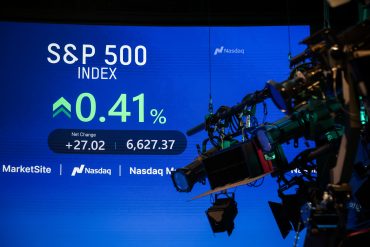
- Federal Reserve
- Interest Rates
- Monetary Policy
Fed Policy Shift Sparks Tech Momentum Across Global Markets
6 minute read

Federal Reserve rate cut sparks tech stock rally as investors anticipate further monetary easing amid cooling job market
Key Takeaways
- Federal Reserve cuts rates 25 basis points to 4.00%-4.25% range, marking first reduction since December with 92% probability of another cut in September.
- Tech stocks surge on rate optimism with Nasdaq futures up 0.5% and sector gaining 38.1% in 2024 as lower rates boost growth stock valuations.
- Mixed labor market signals drive policy as August jobs data shows only 22,000 new positions versus 75,000 expected, pushing unemployment to 4.3%.
Introduction
The Federal Reserve’s latest interest rate cut has ignited fresh optimism across financial markets, with technology stocks leading the charge as investors position for a sustained period of monetary easing. The central bank reduced its benchmark federal funds rate by 25 basis points to a target range of 4.00% to 4.25%, marking its first reduction since December.
Recent indicators suggest that growth of economic activity moderated in the first half of the year. Job gains have slowed, and the unemployment rate has edged up but remains low. Inflation has moved up and remains somewhat elevated.
Key Developments
Federal Reserve Chair Jerome Powell characterized the rate cut as a “risk-management” measure designed to prevent unemployment from spiking. The decision was not unanimous, with new Governor Stephen Miran dissenting in favor of a more aggressive 50 basis point reduction.
Recent economic data has reinforced the Fed’s cautious stance. The Bureau of Labor Statistics reported August nonfarm payrolls added just 22,000 jobs, significantly below market expectations of 75,000. The unemployment rate increased to 4.3%, raising concerns about labor market momentum.
Updated Fed projections reveal most policymakers anticipate two additional cuts in 2025. The CME FedWatch tool indicates a 92% probability of another quarter-point reduction at the September 17 meeting, up from 90% following the latest jobs data.

Market Impact
Technology stocks have emerged as primary beneficiaries of the rate cut speculation. The tech-heavy Nasdaq Composite surged nearly 2% during recent sessions, while the sector has gained 38.1% in 2024. Lower interest rates increase the present value of future cash flows, particularly benefiting growth-oriented technology companies.
Mixed results characterized broader market performance. The S&P 500 snapped back with a 1.5% increase after a four-day losing streak, while the Dow climbed approximately 585 points. The small-cap Russell 2000 jumped more than 2%, reflecting investor appetite for growth-sensitive names.
Individual stock movements reflected the sector rotation dynamics. Palantir shares jumped more than 3% after revenue surpassed $1 billion for the first time, while Nvidia stock fell 2.6% following reports that Chinese regulators instructed tech firms to cease purchasing the company’s AI chips.
U.S. stock index futures rose following the decision, with Investing.com reporting Nasdaq 100 futures gaining 0.5% to 24,575 points. The move reflects the Fed’s response to softening labor market conditions while maintaining its commitment to controlling inflation.
Strategic Insights
The rate cut environment creates distinct advantages for technology companies pursuing growth initiatives. Lower borrowing costs facilitate expansion strategies, mergers and acquisitions, and capital-intensive projects like AI infrastructure development. Gartner projects worldwide IT spending will reach $5.75 trillion in 2025, representing a 9.3% increase over 2024.
Cloud migration trends continue reshaping the competitive landscape. Small and medium businesses are accelerating their shift from on-premises infrastructure to cloud-based services, creating sustained demand for technology providers. Major cloud providers are offsetting reductions in traditional data center buildout by investing heavily in AI functionality and specialized computing infrastructure.
The artificial intelligence sector stands to benefit significantly from easier monetary conditions. Companies like Nvidia and Microsoft lead in AI hardware and software development, while broader market participants integrate AI capabilities into business tools and services. This investment cycle is driving capital budgets across the technology sector.
Expert Opinions and Data
ING analysts expressed skepticism about the Fed’s approach, noting “the market is not convinced by these softest of soft-landing projections” and suggesting additional cuts may be necessary. Their assessment reflects broader market sentiment that current monetary policy may not be sufficiently accommodative given economic headwinds.
Technology executives view the rate environment as an opportunity to accelerate growth initiatives and pursue strategic deals. The improved access to capital comes at a critical time as companies invest in next-generation technologies and expand market reach.
Upcoming economic data releases will provide additional clarity on the Fed’s path forward. The Producer Price Index for August is scheduled for Wednesday release, with economists forecasting a 0.3% increase, moderating from July’s 0.9% surge. Thursday’s Consumer Price Index report is expected to show a 0.3% gain, pushing annual inflation to 2.9%, still above the Fed’s 2% target.
Conclusion
The Federal Reserve’s rate cut represents a pivotal moment for technology stocks and growth-oriented investments. Market participants have responded positively to the prospect of sustained monetary easing, with futures contracts indicating continued optimism heading into upcoming trading sessions.
The combination of supportive monetary policy and robust technology sector fundamentals creates a favorable environment for continued market gains. However, underlying economic uncertainties, including labor market softness and geopolitical tensions, require careful monitoring as investors navigate the evolving landscape.








